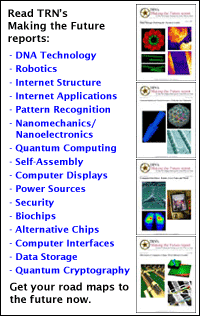
Artificial cells make mini lab
By Eric Smalley, Technology Research NewsIf a brilliant but mentally unstable bacterium wanted to conduct fiendish experiments, it could use as its chemistry lab a network of microscopic containers and tubes created by a Swedish research team.
The researchers used lipids derived from egg yolks or soybeans to make liposomes, which are tiny, artificial sacks that resemble cell membranes. Liposomes have been used as miniature containers in biochemical experiments for years.
The researchers fashioned the liposomes into networks by flattening them under microscope coverslips to hold them in place and then slicing them with a tiny carbon fiber. Like a soap bubble, a bisected liposome forms two daughter liposomes. But unlike daughter soap bubbles, the two daughter liposomes have a narrow tube connecting them.
"The technique... enables us to freely vary the size of the containers, the length of the tube... and the angle between different nanotube extensions emanating from a common container," said Owe Orwar, a biophysical chemistry professor at Chalmers University of Technology in Sweden.
The networks of tubes and containers can be used to guide and mix tiny amounts of substances, allowing the networks to serve as chemical sensors, chemical neural network-type computers and models for studying biochemical reactions in biological cells, said Orwar. They could also be used as templates for microelectronic devices, he said.
The liposomes, at 5 to 100 microns across, can be as small as red blood cells. The tubes connecting the liposomes range from .05 to .3 microns in diameter and 5 to 50 microns long, Orwar said. The tubes are as many as 1,500 times narrower than a human hair.
The research builds on the 1996 discovery that nanotubes can be formed by drawing material from the surface of a liposome, said Orwar. The carbon fiber technique makes it possible to build more complicated networks, he said. The researchers have made networks with as many as 11 interconnected liposomes.
The Swedish team's work "takes us to a next step in the sense that the structures are getting a little more complicated than [those] we put together," said Evan Evans, one of the researchers and who created the first liposome nanotubes. Evans is a professor of physics and pathology at the University of British Columbia and a professor of engineering at Boston College.
The networks created by slicing liposomes can be combined to make even larger networks by fusing liposomes using an electric field, said Orwar's research colleague Roger Karlsson, a graduate student at Goeteborg University. To do this, the researchers apply a short pulse of electricity to the point of contact between adjacent liposomes, which breaks down the liposomes' membranes.
Substances like enzymes, dyes and genetic material can be inserted into individual liposomes and transported between liposomes through the tubes. The researchers have moved a particle from one liposome to another through a tube.
Evans said he is skeptical about the liposome networks being used directly in practical applications. "The key thing... is going to be coming up with a way to make a durable structure," he said. "To do that, you're going to have to... use these [networks] as templates for other structures."
The Swedish researchers are exploring methods for creating three-dimensional liposome networks, said Orwar. Using the liposome networks for biochemical experiments should be possible in two to five years, said Karlsson.
Orwar and Karlsson's research colleagues were Anders Karlsson, Mattias Karlsson, Ann-Sofie Cans, Annette Strömberg and Frida Ryttsén of Göteborg University. They published the research in the January 11, 2001 issue of Nature.
The research was funded by the Royal Swedish Academy of Sciences, the Swedish Natural Science Research Council, the Swedish Research Council for Engineering Sciences in the Swedish Foundation for Strategic Research.
Timeline: 2-5 years
Funding: Government
TRN Categories: Semiconductors and Materials
Story Type: News
Related Elements: Technical paper, "Networks of Nanotubes and Containers," Nature, January 11, 2001
Advertisements:
February 21, 2001
Page One
Artificial cells make mini lab
PDA interface keeps a low profile
Software sifts text to sort Web sites
Light drives microscopic metal gears
Quantum computer design lights dots

News:
Research News Roundup
Research Watch blog
Features:
View from the High Ground Q&A
How It Works
RSS Feeds:
News
Ad links:
Buy an ad link
| Advertisements:
|
 |
Ad links: Clear History
Buy an ad link
|
TRN
Newswire and Headline Feeds for Web sites
|
© Copyright Technology Research News, LLC 2000-2006. All rights reserved.